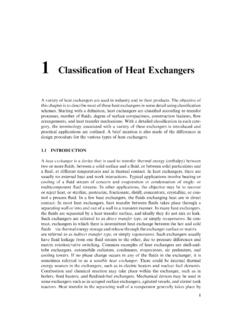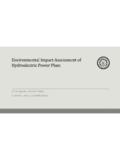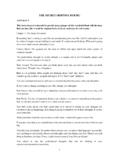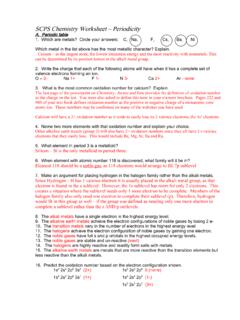Transcription of BACKGROUND AND PRINCIPLE - IIT Delhi
1 Page 1. Indian Institute of Technology Delhi Department of Civil Engineering CEL212 Environmental Engineering (Second Semester 2013-14). Experiment 5: chemical oxygen demand OBJECTIVE: To measure chemical oxygen demand . BACKGROUND AND PRINCIPLE : The chemical oxygen demand (COD) determines the amount of oxygen required for chemical oxidation of organic matter using a strong chemical oxidant, such as, potassium dichromate under reflux conditions. This test is widely used to determine: a) Degree of pollution in water bodies and their self-purification capacity, b) Efficiency of treatment plants, c) Pollution loads, and d) Provides rough idea of Biochemical oxygen demand (BOD) which can be used to determine sample volume for BOD estimation. The limitation of the test lies in its inability to differentiate between the biologically oxidizable and biologically inert material and to find out the system rate constant of aerobic biological stabilization.
2 Most of the organic matters are-destroyed when boiled with a mixture of potassium dichromate and sulphuric acid producing carbon dioxide and water. A sample is refluxed with a known amount of potassium dichromate in sulphuric acid medium and the excess of dichromate is titrated against ferrous ammonium sulphate. The amount of dichromate consumed is proportional to the oxygen required to oxidize the oxidizable organic matter. SELECTION OF METHODS. There are two methods available for COD determination namely open reflux and closed reflux. Open Reflux PRINCIPLE : Suitable for a wide range of wastes with a large sample size. Due to it higher oxidizing ability dichromate reflux method is preferred over other procedures using other oxidants ( potassium permanganate). Oxidation of most organic compounds is up to 95-100% of the theoretical value. Closed Reflux PRINCIPLE : This method is conducted with ampules and culture tubes with pre-measured reagents.
3 Measurement of sample volume and reagent volume are critical. Page 2. This method is economical in the use of metallic salt reagents and generate smaller quantity of hazardous wastes. Volatile organic compounds (VOC) gets completely oxidized in a closed system than the open because of longer contact time with oxidants. chemical Reactions: CnHaObNc+ d Cr2O72- + (8d+c) H+ => nCO2 +[(a+8d-3c)/2]H2O+c NH4+ +2dCr3+ (1). Here d= (2n/3) + (a/6)-(b/3)-(c/2). During experiment, excess dichromate concentration is determined by titrating it with ferrous ammonium sulfate (FAS). The reaction is given by: 6Fe2+ + Cr2O72- + 14 H+ => 6Fe3++ 2Cr3+ +7H2O (2). Here d= (2n/3) + (a/6)-(b/3)-(c/2). SAMPLING AND HANDLING REQUIREMENTS. S. Determination Container Preservation Min Maximum Regulatory N Technique Vol, storage o ml Recommended 1. COD Plastic, Analyze as soon as 100 7 days 28 d Glass possible , or add H2SO4 to pH < 2.
4 Refrigerate REAGENTS: Standard Potassium dichromate (K2Cr2O7) digestion solution, : Add to about 500 mL distilled water g K2Cr2O7, primary standard grade, previously dried at 150 C for 2 h, 167 mL conc. H2SO4, and g HgSO4. Dissolve, cool to room temperature, and dilute to 1000 mL. Sulfuric acid reagent: Add H2SO4 at the rate of g Ag2SO4/kg H2SO4 or g silver sulphate/L. H2SO4. Let stand 1 to 2 d to dissolve and mix. This accelerates the oxidation of straight- chain aliphatic and aromatic compounds. (1 Kg = mL of H2 SO4 and take g of Ag2SO4 to 2 L of H2. SO4 or g of Ag2SO4 to L of H2 SO4). Ferroin Indicator solution: Page 3. This indicator is used to indicate change in oxidation-reduction potential of the solution and indicates the condition when all dichromate has been reduced by ferrous ion. It gives a very sharp brown color change which can be seen in spite of blue color generated by the Cr3+ ions formed on reduction of the dichromate.
5 Standard ferrous ammonium sulfate titrant (FAS), approximately : Dissolve g Fe (NH4)2(SO4) in distilled water. Add 20 mL conc. H2SO4, cool, and dilute to 1000 mL. Standardize solution daily against standard K2Cr2O7. digestion solution as follows: Pipet mL digestion solution into a small beaker. Add 10 mL. reagent water to substitute for sample. Cool to room temperature. Add 1 to 2 drops diluted Ferroin indicator and titrate with FAS titrant. Molarity of FAS solution = [VK2Cr2O7 ] / (VFAS). Where: VK2Cr2O7 = volume of K2Cr2O7 (mL); VFAS = volume of FAS (mL). PROCEDURE: 1. Wash culture tubes and caps with 20% H2SO4 before using to prevent contamination. 2. Place sample ( mL) in culture tube and Add K2Cr2O7 digestion solution ( mL). 3. Carefully run sulphuric acid reagent ( mL) down inside of vessel so an acid layer is formed under the sample-digestion solution layer and tightly cap tubes or seal ampules, and invert each several times to mix completely.
6 4. Place tubes in block digester preheated to 150 C and reflux for 2 h behind a protective shield. 5. Cool to room temperature and place vessels in test tube rack. Some mercuric sulfate may precipitate out but this will not affect the analysis. 6. Add 1 to 2 drops of Ferroin indicator and stir rapidly on magnetic stirrer while titrating with standardized M FAS. 7. The end point is a sharp color change from blue-green to reddish brown, although the blue green may reappear within minutes. 8. In the same manner reflux and titrate a blank containing the reagents and a volume of distilled water equal to that of the sample. 9. COD is given by COD (mg O2 /L) = [(A-B) M 8000) / (V sample). Where: A = volume of FAS used for blank (mL). B = volume of FAS used for sample (mL). M = molarity of FAS. 8000 = milli equivalent weight of oxygen (8) 1000 mL/L. Page 4.]
7 ANSWER THESE QUESTIONS ALSO: 1. Why do the COD analysis and BOD analysis give different results for the same waste? 2. What could be inferred from the following samples concerning the relative ease of biodegradability: Sample A (5-d BOD/COD=24/30) and Sample B (5-d BOD/COD=10/50)? REFERENCE MATERIALS: Page 5. 1) AWWA, WEF, APHA, 1998, Standard Methods for the Examination of Water and Wastewater (Methods: 5220 C. Closed Reflux Titrimetric Method). 2) Sawyer, , McCarty, , and Parkin, 2000. Chemistry for Environmental Engineering 4th Edition. Tata McGraw-Hill Publishing Company Limited. Page 6. Indian Institute of Technology Delhi Department of Civil Engineering CEL212 Environmental Engineering (Second Semester 2013-14). Experiment 5: Dissolved oxygen (4500-O. C. Azide Modification). OBJECTIVES: To determine Dissolved oxygen ( ) concentration in a water sample.
8 BACKGROUND AND PRINCIPLE : The test was first developed by Lajos Winkler while working on his doctoral dissertation in 1888. Dissolved oxygen ( ) levels in environmental water depend on the physiochemical and biochemical activities in water body and it is an important useful in pollution and waste treatment process control. levels in natural waters and wastewaters depend on physical, chemical and biological activities in water body. The solubility of atmospheric oxygen in fresh water ranges from at 0 C to about at 35 C under normal atmospheric pressure. Since it is poorly soluble gas, its solubility directly varies with the atmospheric pressure at any given temperature. SELECTION OF METHODS. Two methods are commonly used are iodometric method membrane electrode procedure. Iodometric Method Titration-based method which depends on oxidizing property of oxygen present in sample rapidly oxidizes the dispersed divalent manganous hydroxide to its higher valency, which is precipitated as a brown hydrated oxide after the addition of NaOH / KOH and KI.
9 Upon acidification, manganese reverts to divalent state and liberates iodine from KI equivalent to the original DO content. The liberated iodine is titrated against Na2S2O3 (N/40) using starch as an indicator Membrane Electrode Procedure Which works based on the rate of diffusion of molecular oxygen across a membrane. Azide Modification (For nitrite-N < mg/L and Ferrous iron<1 mg/L). The azide modification is used to minimize the effect of interfering materials. It removes interference caused by nitrite which is most commonly found interference in biologically treated effluents and in incubated BOD samples. Page 7. chemical Reactions: MnSO4 + 2 KOH Mn (OH)2 + K2SO4 (White Ppt : No ). 2 Mn(OH)2 + O2 2 MnO (OH)2 (Brown Ppt). MnO (OH )2 + 2KI + H2O Mn(OH)2 + I2 + 2 KOH. I2 + 2S2O32- S4O62- + 2I- SAMPLING AND HANDLING REQUIREMENTS. Determination Contai Preservation Min Maximum Regulatory ner Technique Vol, storage ml Recommen ded Electro Glass, Analyze 300 h h de BOD immediately Bottle oxygen , Winkle Glass, Titration may be 300 8h 8h Dissolved r BOD delayed after Bottle acidification REAGENTS: Manganese Sulfate solution: Dissolve 480 g , 400 g or 364 g in distilled water, filter, and dilute to 1L.
10 The MnSO4 solution should not give a color with starch when added to an acidified potassium iodide (KI) solution. Alkali-iodide-azide Reagent: a) For saturated or less than saturated samples: Dissolve 500g NaOH (or 700g KOH). and 150g Kl (or 135g NaI) in distilled water and dilute to 1000mL. Add 10 g sodium azide, NaN3 dissolved in 40 mL distilled water. This solution should not give colour with starch solution when diluted and acidified. b) For supersaturated samples: Dissolve 10g NaN3 in 500mL distilled water. Add 480g NaOH and 750g NaI and stir to dissolve the contents. Sulfuric acid: One mL is equivalent to ~ 3mL alkali-iodide-azide reagent. Starch solution: Dissolve 2 g laboratory-grade soluble starch and g salicyclic acid as preservative in 100 mL hot distilled water. Page 8. Standard sodium thiosulfate titrant: Dissolve g Na2S2O3 .5H2O in distiller water and add mL 6N NaOH or g solid NaOH and dilute to 1000 mL.











